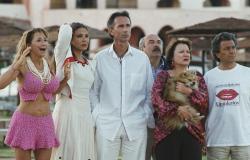The Chairman and CEO of Bulgari since 2013 talks about his passion for the eternal city and his ambition for the house.
In 2011, LVMH bought Bulgari. So what is its ambition for the development of the Group’s jewelry and watchmaking?
LVMH’s jewelry division was still developing, but observation of the big names in the sector proved that the category was growing very strongly, at least as important as that of fashion, of around 8% per year. Bulgari was then focused on Italy and the vacation destinations of Italians, whether the mountains, with Saint-Moritz, or the sea, with Portofino. There was therefore very strong potential for internationalization. The icons of the House were young: the ring B.zero1 was born in the late 1990s, Octo, the record-breaking watch, dates from 2012… Which augured an enormous growth potential. The House was therefore, paradoxically, very recent in terms of status, despite its long history.
What are your goals when you become president and CEO in 2013?
I would say that they were qualitative, psychological. When luxury makes something beautiful, exceptional, relevant, differentiating, I would tend to say that sales follow. A turnover target leads nowhere if it is not aligned with the desirability of the brand. By buying one of the most beautiful jewelry Houses in the world, Bernard Arnault wanted to strengthen this desirability and for Bulgari to be considered worldwide, clearly and spontaneously as essential, in the field of high jewelry in particular. As always at LVMH, the growth, turnover and profitability targets are set by the management of each House in the executive committee, with the teams and markets of the different countries –subject of course to the Group–, because Bernard Arnault wants each president to behave like a true entrepreneur. This is the strength of this Group, because who better than an entrepreneur can have knowledge of his brand, his teams, his competitive environment, his clientele, his products and services to then propose a vision and implement it on a daily basis by aligning all the employees? This is the reason why my objectives, when arriving at the head of Bulgari, were as much qualitative as quantitative. Moreover, if we look at the evolution of Bulgari ten years later, we see that we have moved away from the initial acquisition business plan while delivering much better results than expected.
Bringing Rome back to the heart of the House in a totally explicit way was one of my first decisions when I arrived at Bulgar.
Jean Christophe Babin – Chairman and CEO of Bulgari
What image did you have of the House and how did you change it?
In my eyes, it was above all a jewelry house with a Mediterranean sensibility that made it very different and interesting compared to other Parisian or New York brands. It had experienced a very sustained growth rate in the 1990s, but this was mainly thanks to excessive diversification and it had moved away from the major genetic codes of the brand, whether those of jewelry symbols like B.zero1 or Serpenti or those linked to Romanity, with a transversal and cultural dimension. But we are an Italian company: entering a Bulgari store in Hong Kong is like being on vacation in Italy! Everything has to resonate Italian. This is why it is important for me to specify that numbers and desirability must coexist.
Even more than Italy, it is Rome that you have put back in the spotlight…
Bringing Rome back to the heart of the house in a totally explicit way was one of my first decisions when I arrived at Bulgari. There are two thousand seven hundred years of architecture in this city, and yet the whole remains very homogeneous because everything was built in a grandiose way, whatever the period. Despite the different styles, this gigantism has created an aesthetic balance, in a rather paradoxical way because it could have created an impression of chaos. Bulgari jewelry is a bit like the city: the large colored stones, the varied inspirations. When the great jewelry houses were born, during the 19th century th century, there was of course no television, no Internet, newspapers remained very local, each city became the aesthetic melting pot of specific inspirations: Paris, monochromatic with its cut stone and its rigorous Haussmannian architecture, naturally inspired a jewelry very different from ours. Bulgari, mirror of Rome, was born from this architectural, artistic context which strongly influenced it; the heritage of the house was thus created. Of course, wisdom is to make it evolve without changing it. Bulgari’s Romanness is also expressed in the wealth of inspirations. The Roman Empire is a formidable mix of cultures that are at once Greek, Egyptian, Phoenician, Etruscan, Carthaginian. It built its strength and power by integrating both what preceded it and what it conquered. Between Augustus and Constantine, there were approximately 80 emperors, more than a third of whom were of foreign origin.
Bulgari’s Roman roots are a source of pride
Jean Christophe Babin
Your presidency is therefore marked by the refocusing on the historical business and the fundamentals of Bulgari. Are these two elements alone enough to explain the success of the House?
Yes, but there is a third element that should not be underestimated: at the end of the 2000s, Bulgari had reached a breaking point, turnover stagnated despite several layers of diversification. The family was even convinced that the business had finally reached its full potential, a sort of plateau, and that it could be sold. Fortunately, the finding was wrong. Bulgari was a family business that had grown remarkably, but had not yet reached its full potential. It had already proven that it was a daring House and had already succeeded in asserting its own identity. However, it could go even further to compete with the big names in fine jewelry. From the outset, I wanted to raise the level of ambition.
In my opinion, as someone who is not Roman by origin, this anchoring of the House must be a source of pride: Rome invented the Western world, defined its art and architecture, shaped the laws that are still in force in most countries… The Roman people are one of the founding peoples of modern humanity and remain today the custodians, heirs of a unique culture. This awareness was an electroshock for the employees, who thus realized, without arrogance, that the House had nothing to envy from the leaders of the jewelry market.
Bvlgari
What were the major stages of Bulgari’s development?
Once these fundamentals were established, and above all shared – the important thing in a company is the employees’ support for the strategy – everything went quite smoothly. A quick look at the brand showed the many things that needed to be done to accelerate trust and growth. It was tactical but relatively simple because the framework was set. Here are a few examples: the counters were not very well stocked, although we had a large stock. We did not yet offer watches in gold and steel. Yellow gold was not often enough offered among our best-sellers, even though it is the most popular colour, particularly in the United States. However, the customer’s search for authenticity required it – especially since the Covid-19 period. You only have to go to any archaeological museum to realise that a pharaoh’s funeral mask is made of yellow gold, not rose gold! Authenticity depends on the original colour of the material. The Divas’ Dream collection is a great success, it has allowed to breathe more femininity into the brand, softness too, and romanticism. It is a pattern inspired by the mosaics of the Baths of Caracalla, so typically Roman, allowing to develop the narrative of the House – which is an obsessive point for me –, but which at the same time recalls the ginkgo leaf, sacred in China and Japan.
What will be the next steps?
Bulgari has refocused on its core businesses, giving each one clear roles. The core will of course remain high jewelry and jewelry. Watchmaking is walking on its two legs: on the one hand, jewelry watches like Serpenti, Divas’ Dream or Lucea – very linked to the original craft but also to the Roman nature of the House –, on the other hand, contemporary watches like Octo which are multiplying world records. Perfumes and leather goods attract young customers. Today, most of our bags come from the Serpenti line. Perfumes are starting to converge towards the overall DNA of the brand, even if it is a category that is slower to evolve, since distribution also depends on partners. We created the LE GEMME collection, inspired by the Gems Road, a journey that tells the story of the precious gems that nature offers, and which are the very essence of these multifaceted perfumes. These are exceptional perfumes both in terms of their content (the scents, the composition, their sophistication) and thanks to the obelisk-shaped bottles that anchor the collection in the imagination of Antiquity and make them true jeweled perfumes. The hotels nourish the House from above by offering an exceptional experience. The future of Bulgari will be the continuation and intensification of this obsessive focus on jewelry and watchmaking with a matrix that is Rome. More than anything, it is about keeping both this uniqueness, this exclusivity and a narrative that is unique in the world, since wearing Bulgari, whatever the product category, is in a certain way being the custodian of twenty-seven centuries of art and architectural history. Whether conceptually, through a clear inspiration, or concretely, thanks to the famous Monete necklaces for example, set with imperial coins. In terms of geographical development, there are no countries or major locations where Bulgari is not present today.
Today, would you say you feel Roman?
Yes, completely! I am proud to be Italian at heart. It’s not just Rome, either. I lived in Milan for ten years, my children are Italian-French-Swiss, and I often go to Nice and the Riviera, which are, you could say, the Italian part of France! I consider Italy my first country.






